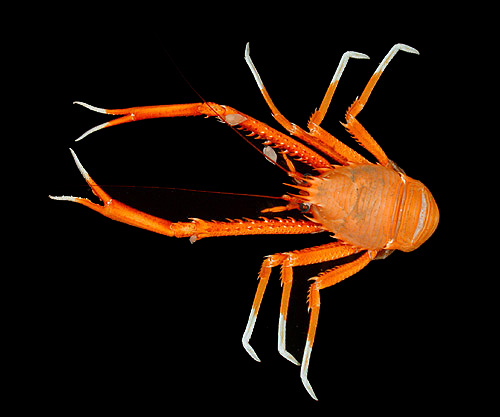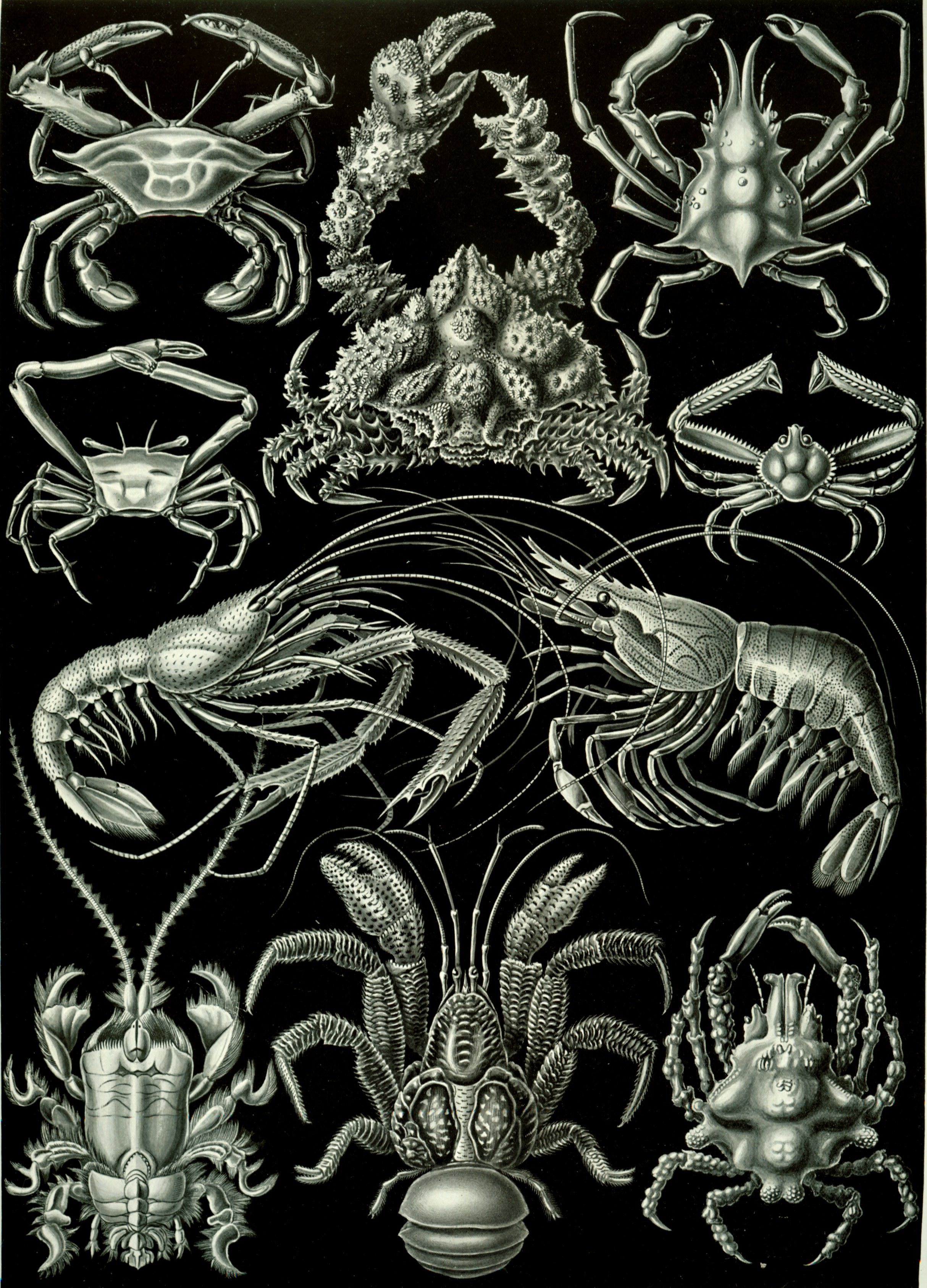|
Anomura
Anomura (sometimes Anomala) is a group of decapod crustaceans, including hermit crabs and others. Although the names of many anomurans include the word ''crab'', all true crabs are in the sister group to the Anomura, the Brachyura (the two groups together form the clade Meiura). Description The name Anomura derives from an old classification in which Reptantia, reptant decapods were divided into Macrura (long-tailed), Brachyura (short-tailed) and Anomura (differently-tailed). The alternative name Anomala reflects the unusual variety of forms in this group; whereas all crabs share some obvious similarities, the various groups of anomurans are quite dissimilar. The group has been moulded by several instances of carcinisation – the development of a crab-like body form. Thus, the king crabs (Lithodidae), porcelain crabs (Porcellanidae) and hairy stone crab (Lomisidae) are all separate instances of carcinisation. As decapods (meaning ''ten-legged''), anomurans have ten pereiopods, ... [...More Info...] [...Related Items...] OR: [Wikipedia] [Google] [Baidu] |
Carcinisation
Carcinisation (American English: carcinization) is a form of convergent evolution in which non-crab crustaceans evolve a crab-like body plan. The term was introduced into evolutionary biology by Lancelot Alexander Borradaile, who described it as "the many attempts of Nature to evolve a crab". Definition of carcinised morphology It was stated by L. A. Borradaile in 1916 that: Keiler et al., 2017 defines a carcinised morphology as follows: * "The carapace is flatter than it is broad and possesses lateral margins." * "The sternites are fused into a wide sternal plastron which possesses a distinct emargination on its posterior margin." * "The pleon is flattened and strongly bent, in dorsal view completely hiding the tergites of the fourth pleonal segment, and partially or completely covers the plastron." An important and visually evident marker of difference between true crabs and carcinised Anomura is the number of leg pairs. While Brachyura (true) crabs have four ... [...More Info...] [...Related Items...] OR: [Wikipedia] [Google] [Baidu] |
Hippoidea
Hippoidea is a superfamily of decapod crustaceans known as mole crabs or sand crabs. Ecology Hippoids are adapted to burrowing into sandy beaches, a habit they share with raninid crabs, and the parallel evolution of the two groups is striking. In the family Hippidae, the body is almost ovoid, the first pereiopods have no claws, and the telson is long, none of which are seen in related groups. Unlike most other decapods, sand crabs cannot walk; instead, they use their legs to dig into the sand. Members of the family Hippidae beat their uropods to swim. Apart from the polar regions, hippoids can be found on beaches throughout the world. Larvae of one species have also been found in Antarctic waters, despite the lack of suitable sandy beaches in the Antarctic. Classification Alongside hermit crabs and allies (Paguroidea), squat lobsters and allies ( Galatheoidea) and the hairy stone crab (''Lomis hirta'', Lomisoidea), Hippoidea is one of the four groups that make up the in ... [...More Info...] [...Related Items...] OR: [Wikipedia] [Google] [Baidu] |
Aegloidea
The Aeglidae are a family of freshwater crustaceans currently restricted to South America. They are the only anomurans to be found in fresh water except for a single hermit crab species, '' Clibanarius fonticola'', on Espiritu Santo, Vanuatu. They live between 20° S and 50° S, at altitudes between . Description Aeglids resemble squat lobsters in that the abdomen is partly tucked under the thorax. The notable sexual dimorphism in the abdomen is related to the behaviour of carrying fertilised eggs on the pleopods. The carapace length of the largest species may approach , but most are considerably smaller. Aeglids are omnivorous, preferring plant matter, but also eating adult insects, molluscs, fish and fly larvae. The internal anatomy has been described for ''Aegla cholchol'' and generally resembles that of other anomurans, particularly galatheoid squat lobsters. The morphology of the antennal gland bladder differs from that in other anomurans in having a twisted tubular stru ... [...More Info...] [...Related Items...] OR: [Wikipedia] [Google] [Baidu] |
Hermit Crab
Hermit crabs are anomuran Decapoda, decapod crustaceans of the superfamily (taxonomy), superfamily Paguroidea that have adapted to occupy empty scavenged mollusc shells to protect their fragile exoskeletons. There are over 800 species of hermit crab, most of which possess an asymmetric abdomen concealed by a snug-fitting shell. Hermit crabs' soft (non-Marine biogenic calcification, calcified) abdominal exoskeleton means they must occupy shelter produced by other organisms or risk being defenseless. The strong association between hermit crabs and their shelters has significantly influenced their biology. Almost 800 species carry mobile shelters (most often calcified Gastropod shell, snail shells); this protective mobility contributes to the diversity and multitude of these crustaceans which are found in almost all marine environments. In most species, development involves metamorphosis from symmetric, free-swimming larvae to morphologically asymmetric, benthic zone, benthic-dwellin ... [...More Info...] [...Related Items...] OR: [Wikipedia] [Google] [Baidu] |
Paguroidea
Hermit crabs are anomuran decapod crustaceans of the superfamily Paguroidea that have adapted to occupy empty scavenged mollusc shells to protect their fragile exoskeletons. There are over 800 species of hermit crab, most of which possess an asymmetric abdomen concealed by a snug-fitting shell. Hermit crabs' soft (non- calcified) abdominal exoskeleton means they must occupy shelter produced by other organisms or risk being defenseless. The strong association between hermit crabs and their shelters has significantly influenced their biology. Almost 800 species carry mobile shelters (most often calcified snail shells); this protective mobility contributes to the diversity and multitude of these crustaceans which are found in almost all marine environments. In most species, development involves metamorphosis from symmetric, free-swimming larvae to morphologically asymmetric, benthic-dwelling, shell-seeking crabs. Such physiological and behavioral extremes facilitate a transition to ... [...More Info...] [...Related Items...] OR: [Wikipedia] [Google] [Baidu] |
Crab
Crabs are decapod crustaceans of the infraorder Brachyura (meaning "short tailed" in Greek language, Greek), which typically have a very short projecting tail-like abdomen#Arthropoda, abdomen, usually hidden entirely under the Thorax (arthropod anatomy), thorax. Their exoskeleton is often Sclerotization, thickened and hard. They generally have Arthropod leg, five pairs of legs, and they have "Pincers (tool), pincers" or "claws" on the ends of the frontmost pair, scientifically termed the ''chelae''. They are present in all the world's oceans, Freshwater crab, in freshwater, and Terrestrial crab, on land, often hiding themselves in small crevices or burrowing into sediment. Crabs are omnivores, feeding on a variety of food, including a significant proportion of Algae eater, algae, as well as Detritivore, detritus and other invertebrates. Crab meat, Crabs are widely consumed by humans as food, with over 1.5 million tonnes Crab fisheries, caught annually. True crabs first appeared ... [...More Info...] [...Related Items...] OR: [Wikipedia] [Google] [Baidu] |
Eocarcinoidea
Eocarcinoidea is a superfamily of fossil decapod crustaceans. Formerly thought to be the earliest true crabs, they are now thought to be the oldest members of the Anomura Anomura (sometimes Anomala) is a group of decapod crustaceans, including hermit crabs and others. Although the names of many anomurans include the word ''crab'', all true crabs are in the sister group to the Anomura, the Brachyura (the two groups .... Two species are included, each in its own family-taxon: '' Eocarcinus praecursor'' (Eocarcinidae) and '' Platykotta akaina'' (Platykottidae). References Anomura Norian first appearances Early Jurassic first appearances {{paleo-crustacean-stub ... [...More Info...] [...Related Items...] OR: [Wikipedia] [Google] [Baidu] |
Decapod
The Decapoda or decapods, from Ancient Greek δεκάς (''dekás''), meaning "ten", and πούς (''poús''), meaning "foot", is a large order of crustaceans within the class Malacostraca, and includes crabs, lobsters, crayfish, shrimp, and prawns. Most decapods are scavengers. The order is estimated to contain nearly 15,000 extant species in around 2,700 genera, with around 3,300 fossil species. Nearly half of these species are crabs, with the shrimp (about 3,000 species) and Anomura including hermit crabs, king crabs, porcelain crabs, squat lobsters (about 2500 species) making up the bulk of the remainder. The earliest fossils of the group date to the Devonian. Anatomy Decapods can have as many as 38 appendages, arranged in one pair per body segment. As the name Decapoda (from the Greek , ', "ten", and , '' -pod'', "foot") implies, ten of these appendages are considered legs. They are the pereiopods, found on the last five thoracic segments. In many decapods, one pair o ... [...More Info...] [...Related Items...] OR: [Wikipedia] [Google] [Baidu] |
Porcelain Crab
Porcelain crabs are decapod crustaceans in the widespread family Porcellanidae, which superficially resemble true crabs. They have flattened bodies as an adaptation for living in rock crevices. They are delicate, readily losing limbs when attacked, and use their large claws for maintaining territories. They first appeared in the Tithonian age of the Late Jurassic epoch, 145–152 million years ago. Description Porcelain crabs are small, usually with body widths less than . They share the general body plan of a squat lobster, but their bodies are more compact and flattened, an adaptation for living and hiding under rocks. Porcelain crabs are quite fragile animals, and often shed their limbs to escape predators, hence their name. The lost appendage can grow back over several moults. Porcelain crabs have large chelae (claws), which are used for territorial struggles, but not for catching food. The fifth pair of pereiopods is reduced and used for cleaning. Evolution Porcelain cra ... [...More Info...] [...Related Items...] OR: [Wikipedia] [Google] [Baidu] |
Galatheoidea
The Galatheoidea are a superfamily of decapod crustaceans comprising the porcelain crabs and some squat lobsters. Squat lobsters within the three families of the superfamily Chirostyloidea are not closely related to the squat lobsters within the Galatheoidea. The fossil record of the superfamily extends back to the Middle Jurassic genus '' Palaeomunidopsis''. Classification These families and genera are included: ; Galatheidae *† '' Acanthogalathea'' – Upper Eocene * '' Alainius'' * '' Allogalathea'' * '' Allomunida'' * '' Coralliogalathea'' * '' Fennerogalathea'' * '' Galathea'' * '' Janetogalathea'' * '' Lauriea'' *† '' Lessinigalathea'' – Lower Eocene *† '' Lophoraninella'' – Upper Cretaceous *† '' Luisogalathea'' – Upper Cretaceous * '' Macrothea'' *† '' Mesogalathea'' – Upper Jurassic to Cretaceous * '' Nanogalathea'' *† '' Palaeomunida'' – Upper Jurassic to Oligocene * '' Phylladiorhynchus'' *† '' Spathagalathea'' – Upper Eo ... [...More Info...] [...Related Items...] OR: [Wikipedia] [Google] [Baidu] |
Chirostyloidea
Chirostyloidea is an anomuran superfamily with squat lobster-like representatives. It comprises the three families Chirostylidae, Eumunididae and Kiwaidae. Although representatives of Chirostyloidea are superficially similar to galatheoid squat lobsters, they are more closely related to Lomisoidea and Aegloidea together forming the clade In biology, a clade (), also known as a Monophyly, monophyletic group or natural group, is a group of organisms that is composed of a common ancestor and all of its descendants. Clades are the fundamental unit of cladistics, a modern approach t ... Australopoda. No fossils can be confidently assigned to the Chirostyloidea, although '' Pristinaspina'' may belong either in the family Kiwaidae or Chirostylidae. Genera Chirostyloidea contains the following families and genera: ; Chirostylidae Ortmann, 1892 *'' Chirostylus'' Ortmann, 1892 *† '' Eouroptychus'' De Angeli & Ceccon, 2012 *'' Gastroptychus'' Caullery, 1896 *'' Hapaloptyx'' ... [...More Info...] [...Related Items...] OR: [Wikipedia] [Google] [Baidu] |
Reptantia
Reptantia is a clade of decapod crustaceans named in 1880 which includes lobsters, crabs and many other well-known crustaceans. Classification In older classifications, Reptantia was one of the two suborders of Decapoda alongside Natantia, with Reptantia containing the walking forms, and Natantia containing the swimming forms (prawns, shrimp and boxer shrimp). However, in 1963 Martin Burkenroad found Natantia to be paraphyletic and invalid, and instead split Decapoda into the two suborders of Dendrobranchiata (prawns) and Pleocyemata. Pleocyemata contains all the members of the Reptantia (including crabs, lobsters, crayfish, and others), as well as the Stenopodidea ("boxer shrimp"), and Caridea (true shrimp). Reptantia remains a valid monophyletic grouping, but is now no longer ranked as a suborder. Anatomy The name Reptantia means "those that walk", and contains those decapods whose primary mode of locomotion is to walk along a surface using the pereiopods rather than ... [...More Info...] [...Related Items...] OR: [Wikipedia] [Google] [Baidu] |





